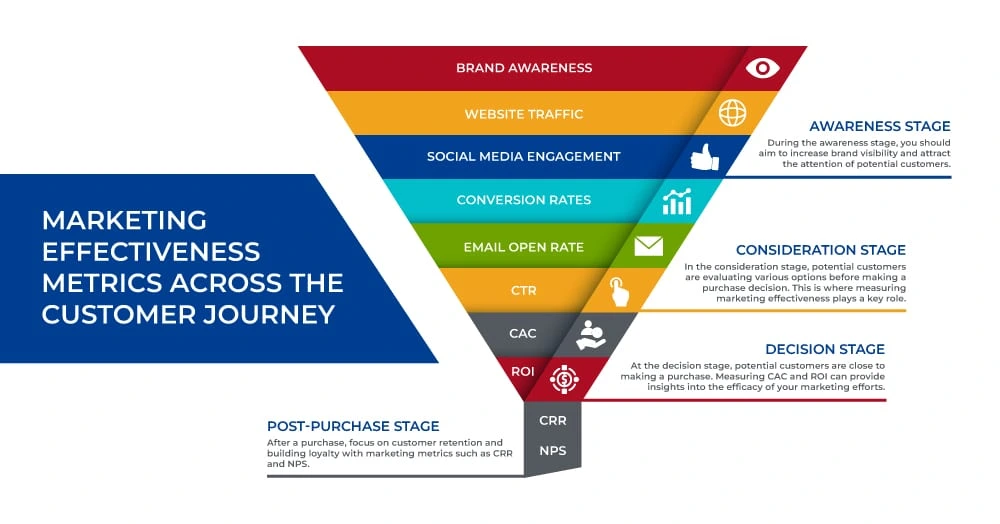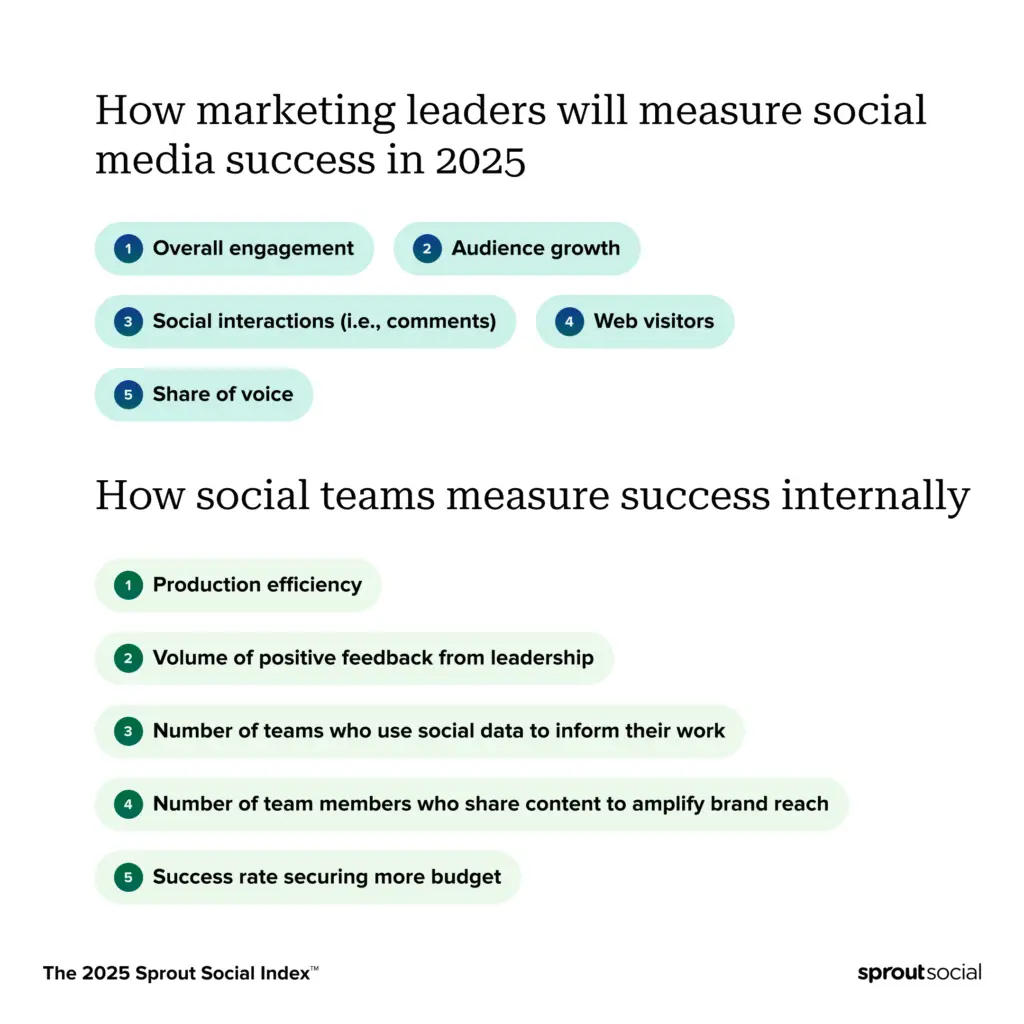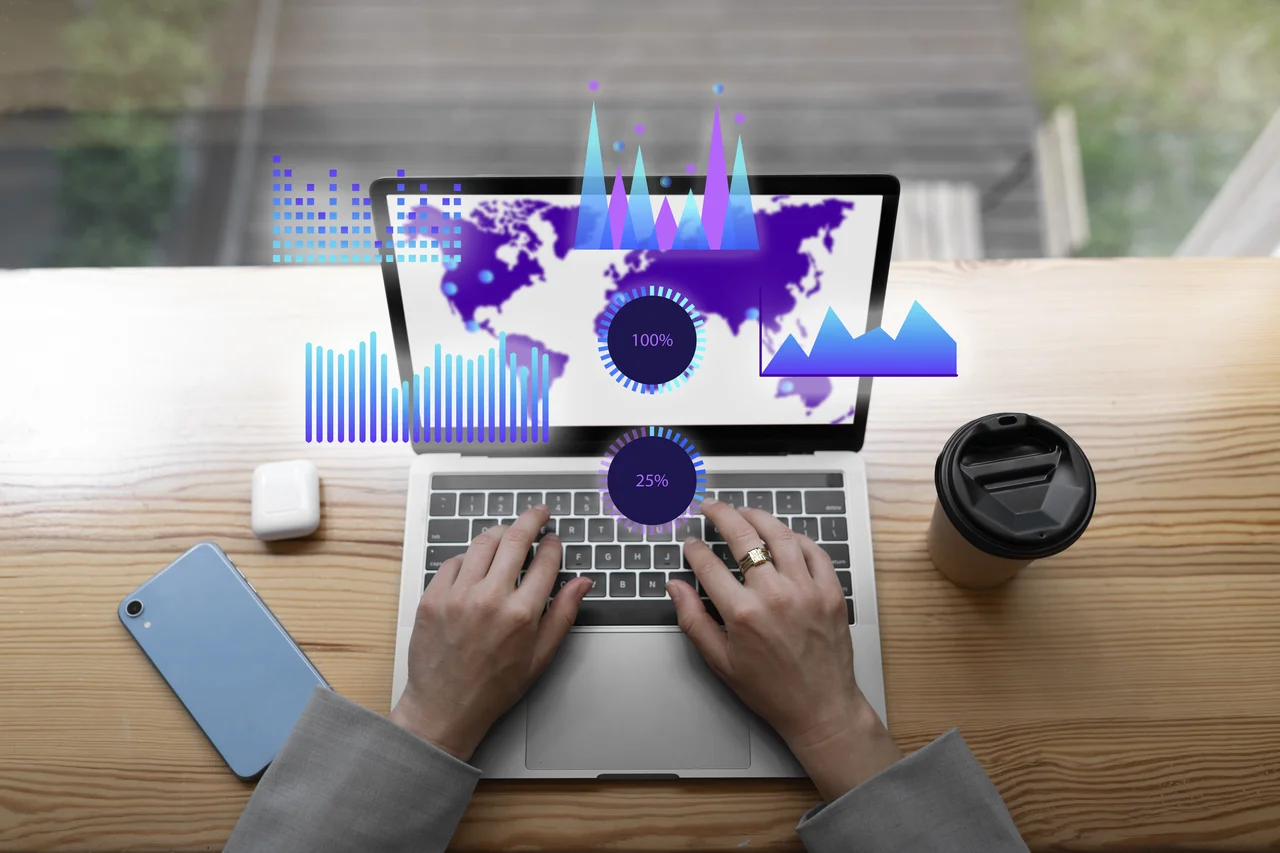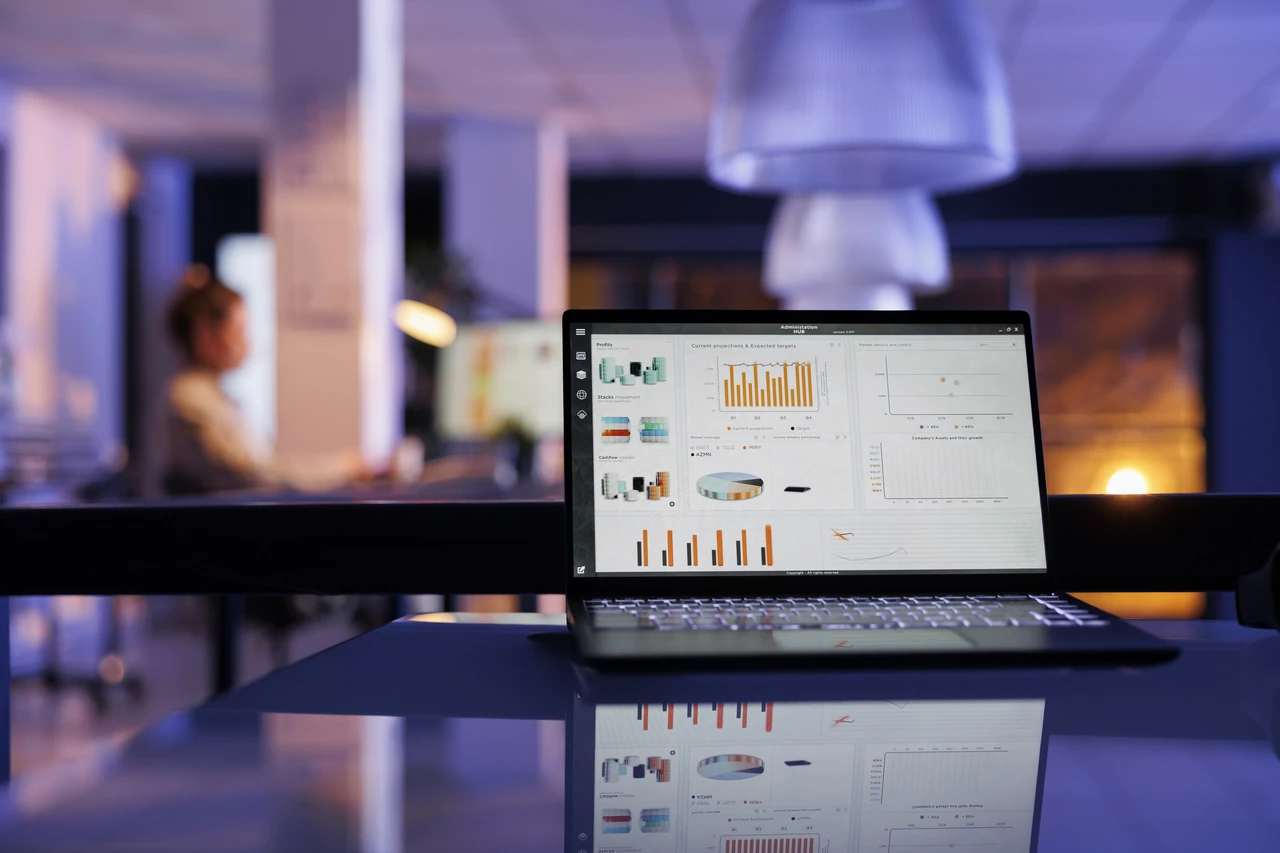Listen to article
Are traditional marketing metrics giving you the whole picture? Maybe not. As we navigate an increasingly complex digital landscape, marketers are realizing that old-school metrics aren’t enough to gauge true marketing success.
Instead, there’s a shift towards a more holistic approach, prioritizing engagement, meaningful connections, and, ultimately, return on investment. Factors like AI-driven advertising, the need to adapt to AI-driven search results, and the enduring importance of content marketing all play a role in how B2B businesses should adapt their marketing strategies in 2025.
But what KPIs really matter in this new era? How can you leverage emerging trends like video to drive brand awareness and sales?
In this article, we’ll explore the key marketing success metrics that will define success in 2025, providing actionable insights to help you stay ahead of the curve.
AI in Advertising: From Smarter Targeting to Scalable Creativity
Artificial Intelligence (AI) is no longer a buzzword in advertising—it’s the beating heart of modern campaign optimization and personalization. As consumers demand relevant, meaningful experiences at every touchpoint, marketers are turning to AI to not just meet these needs but exceed them. Major players like Google and Microsoft are taking the lead, integrating AI-powered tools that allow advertisers to work smarter and deliver hyper-relevant content at scale. Whether it’s refining bidding strategies or crafting copy that resonates with user intent, the future of advertising is undeniably AI-driven.
- Google Ads is evolving with AI-powered precision, enabling advertisers to fine-tune bids, create hyper-relevant ads, and target ideal audiences with accuracy. Source
- Microsoft Advertising is embracing generative AI innovations, offering features like Conversational Ad experiences, Ads for Chat API, and Copilot to supercharge engagement and streamline ad creation. Source
Key Takeaway
The integration of AI in advertising isn’t just about saving time—it’s about creating campaigns that are more intelligent, intuitive, and impactful. Platforms like Google and Microsoft are proving that AI can take advertisers beyond simple automation, using data to predict user behavior and deliver ads that feel tailor-made. For marketers, this means more time to focus on strategy and creativity while letting AI handle the heavy lifting of optimization and targeting. With AI’s unique ability to scale personalization, the gap between a brand’s message and consumer relevance is shrinking faster than ever.
Pro Tip:
Dive into AI tools by testing features like keywordless campaigns or conversational ad interfaces. Use the insights AI provides, not just for better targeting but to inform your overall content strategy and uncover untapped customer needs. For businesses looking to integrate AI into broader marketing efforts, exploring digital marketing strategies for small businesses can provide valuable guidance on maximizing reach and impact.
Rethinking SEO Strategies in the Era of AI-Powered Search
The evolution of AI-powered search tools, such as Google’s AI Overviews, has disrupted the digital marketing landscape, challenging traditional SEO strategies. With search engines increasingly aiming to answer user queries directly on the results page, the battle for visibility has become more complex. For brands, this means shifting focus from clicks to delivering value that stands out amid AI-generated summaries.
- AI Overviews and Google’s Helpful Content Update have led to a decline in blog traffic for sites that rely heavily on question-based, top-of-funnel content, as users receive direct answers without clicking through. Source
- The prominence of AI Overviews has dropped significantly since their beta phase, appearing for only 7% of U.S. search queries in May 2024, compared to a staggering 84% visibility during testing. Source
Key Takeaway
Adopting a forward-thinking approach is vital in this AI-driven search era. Instead of competing with AI for quick answers, marketers can turn this challenge into an opportunity by crafting in-depth, value-rich content that offers unique insights unavailable in AI summaries. Thought leadership, actionable advice, and multimedia experiences (e.g., videos or interactive tools) can create a compelling reason for users to visit your site. For businesses looking to take their strategy to the next level, considering outsourcing SEO services can ensure that expert insights and innovative techniques are applied, helping their content stand out in a competitive landscape.
Pro Tip:
Keep an eye on how AI search features evolve, and focus on optimizing for intent-driven, niche content that complements rather than competes with AI-generated answers.
Metrics That Prioritize Connection Over Clicks

Source: Blue Atlas Marketing
In a landscape where consumers are inundated with content, B2B marketers are moving away from measuring success solely by vanity metrics like page views or follower counts. Instead, the focus has shifted to metrics that reveal deeper audience engagement and foster genuine, long-term connections. This reflects a broader understanding that quality interactions, not just quantity, are what drive sustainable growth and customer loyalty.
-
- 69% of B2B marketers leverage website engagement as a primary metric for evaluating content performance, followed by conversions (67%), website traffic (65%), and email engagement (64%). Source
- 83% of marketers now prioritize content quality over quantity, even if it means publishing less frequently. Source
Key Takeaway
This movement emphasizes that the “more is better” era of content marketing is fading. Instead, brands are focusing on personalized, value-driven content that genuinely resonates with their ideal audience. By tracking engagement metrics that align with audience behaviors and preferences, marketers can craft campaigns that not only attract attention but also build trust and loyalty.
Pro Tip:
Don’t just track engagement—act on it. Analyze the data behind website interactions, email opens, and conversions to uncover patterns and pain points. Then, use these insights to refine your strategy and deliver even more relevant, high-quality content. Tools like Google Analytics and HubSpot can help you dive deeper into understanding what drives meaningful connections.
Why Content Marketing is Still the Backbone of B2B Success
In a world where B2B buyers demand value-driven, personalized experiences, content marketing holds its ground as an indispensable tool for businesses. It’s no longer just about producing content—it’s about creating resources that resonate, educate, and inspire action across every stage of the buyer’s journey. To do this effectively, marketers are shifting their focus from vanity metrics like pageviews to more meaningful indicators such as engagement, ROI, and audience retention. Let’s take a closer look at how content marketing is evolving and the data driving its importance:
- Content marketing remains a cornerstone of B2B sales strategies, effectively capturing top-of-funnel prospects, positioning brands as thought leaders, driving engagement, and delivering value to targeted audiences. Source
- A global survey in July 2023 revealed that 69% of B2B marketers planned to allocate funds to video content marketing in 2024. Source
- In addition to video, 21% of B2B marketers planned to invest in digital events, and 47% highlighted in-person events as key investment areas for content marketing in 2024. Source
- 45% of B2B marketers anticipate an increase in their content marketing budget in 2024, with significant investments expected in video content (69%) and thought leadership initiatives (53%). Source
- Although videos are rapidly overtaking them, online articles continue to be a widely successful marketing content form. Source
- 70% of marketers report that blog articles provide them with the best ROI in the early stages of lead generation. Source
- Updating high-performance articles on your blog can lead to a 146% surge in traffic. Source
- Blogs that include video marketing receive three times more inbound links than text-only articles. Source
Key Takeaway
In the evolution of successful B2B marketing, content is no longer just “king”—it’s the entire kingdom. From the rise of short-form videos to the enduring ROI potential of evergreen blog posts, a multifaceted content strategy is essential for standing out in crowded marketplaces. The data shows two critical trends: one, video content is non-negotiable for capturing attention and driving engagement; two, blogs and thought leadership content are still highly effective for generating leads and establishing industry authority. Together, they provide a powerful foundation for a results-driven approach.
Pro Tip:
Amplify your content’s reach and performance by repurposing it across different formats. For example, transform blog posts into engaging video tutorials or infographics to boost visibility and attract diverse audience personas. Also, regularly audit your content to identify high-performing assets—updating and optimizing these can deliver exponential traffic growth and long-term digital marketing ROI.
Fine-Tuning Content Performance: Strategic Publishing, Formats, and Data Utilization
In a world saturated with digital content, the ability to strategize and optimize your content creation efforts can elevate your brand above the noise. Success hinges not just on producing content but on ensuring it’s well-timed, impactful, and backed by measurable data. Forward-thinking marketers are embracing a mix of consistent publishing schedules, long-form content, and data-driven insights to boost visibility, rankings, and audience engagement. Below, we break down some powerful content performance statistics and actionable takeaways.
- 55% of content marketers report that frequent publishing significantly improves search engine rankings. Source
- 46% of marketers schedule their content two weeks to a month in advance to maintain consistency and visibility. Source
- Long-form content remains king, with 60% of marketers identifying it as the most impactful format for achieving results. Source
- 57% of marketers assert that content creation plays a larger role in SEO rankings compared to backlinking efforts. Source
- The global population of internet users is anticipated to hit 6 billion by 2027, intensifying competition and the demand for skilled digital strategists. Source
- Alarmingly, 44% of businesses lack a clear, quantitative understanding of their marketing impact, limiting strategic optimization. Source
- Despite 87% of marketers believing data is underutilized within their companies, only a fraction effectively integrates it into their content strategies. Source
- Conversion rates are the top KPI for more than one-third of marketing leaders, emphasizing the need for content that drives actionable results. Source
- Nearly half (47%) of marketers are failing to track ROI for content marketing efforts, missing out on critical insights for budget allocation and improvement. Source, Source
Key Takeaway
The future of content performance lies at the intersection of strategic planning and data utilization. Consistency in publishing, a focus on engaging long-form content, and a commitment to uncovering actionable insights via analytics can create a recipe for success. However, as digital competition grows fiercer with billions of users online, the stakes for marketers to deliver high-quality, data-informed content have never been higher. By integrating robust tracking tools and aligning formats to meet audience preferences, you can refine your approach and stay ahead of industry demands.
Pro Tip:
Build a dynamic content calendar that allows flexibility while preserving regularity. Test various content formats, from articles to interactive media, to see what resonates most with your audience. Most importantly, cement your strategy with analytics tools to measure ROI, pinpoint gaps, and adjust tactics for sustained growth.
Prioritizing High-ROI Marketing Channels

Source: Sprout Social
Success in marketing today isn’t about spreading your budget thin across every available channel—it’s about doubling down on what works. Marketers are becoming sharper in their approach, directing resources towards strategies that consistently deliver measurable returns. Especially in a competitive environment where every dollar counts, the focus on ROI-driven channels like email marketing, SEO, and automation is not just a smart choice—it’s a necessity.
- Email marketing continues to outperform with the highest ROI, outpacing SEO, mobile marketing, and content marketing. Source
- 94% of small businesses are set to increase their digital marketing budgets in 2024, reflecting a strong commitment to these profitable strategies. Source
- Automated email campaigns generate 20% more leads compared to their non-automated counterparts. Source
Key Takeaway
By prioritizing ROI-focused channels, businesses gain two major advantages: greater financial efficiency and more actionable data to refine their efforts. For instance, email marketing doesn’t just deliver high ROI—it also provides insights into customer behavior, allowing marketers to create more personalized, effective outreach. Taking it a step further, automation tools ensure campaigns are timely and relevant, which significantly enhances lead generation.
Pro Tip:
Combine high-ROI channels like email marketing with data-driven automation for exponential results. Focus on what works in email marketing—such as list segmentation, compelling subject lines, clear calls-to-action, and mobile optimization—to maximize impact. Tools like Klaviyo or ActiveCampaign can help you create personalized workflows that target the right audience at the right time, amplifying both engagement and profitability.
Why Video Marketing Is the Cornerstone of Modern B2B Strategies
In the fast-paced, content-saturated world of B2B marketing, video has emerged as a non-negotiable for brands striving to break through the noise. Today’s decision-makers are busier than ever, and video offers a unique opportunity to deliver complex messages in a digestible, attention-grabbing format. From increasing brand visibility to directly driving revenue, the advantages of video marketing are reshaping how businesses connect with their audiences.
- An incredible 87% of marketers report a direct increase in sales as a result of leveraging video content. Source
- Video content has significantly enhanced brand awareness for 90% of marketers, making it a top tool in the awareness stage of the funnel. Source
- 82% of consumers say video content is influential in their purchasing decisions—demonstrating its power in bridging the gap between consideration and conversion. Source
- The adoption of video marketing continues to climb, with 91% of businesses leveraging it in their strategies, up from 86% in 2022. Source
- Social media posts with video content earn 48% more views and are shared a staggering 1,200% more frequently than those with just text and images. Source
- B2B marketers rank video as the most effective type of content, thanks to its versatility across platforms like email, social media, and websites. Source
Key Takeaway
With video delivering measurable results—from skyrocketing engagement rates on social media to directly influencing purchase decisions—it’s clear that it must be a foundational element of any B2B marketing strategy. The business world is increasingly visual, and audiences expect brands to meet them where they are, with content that informs, entertains, and ultimately influences action. Whether it’s bite-sized social videos, product demos, or thought leadership content, businesses that fail to embrace video risk being left behind.
Pro Tip:
Don’t just create videos—create strategic videos. Focus on tailoring your content to your audience’s pain points, aligning it with where they are in the buyer’s journey. Leverage analytics tools to track which types of videos are driving the most impact, and consider experimenting with formats like explainer videos, testimonials, or interactive product tours to keep your strategy fresh and results-driven.
Conclusion
As marketing continues to evolve, the shift toward smarter, data-driven strategies is undeniable. From AI-powered advertising to video marketing’s dominance, the tools and tactics available today are more dynamic than ever, allowing brands to connect with audiences in meaningful ways. The emphasis on personalization, engagement, and ROI-driven approaches reflects a broader trend: brands are no longer just chasing clicks or impressions—they’re striving for impact. Whether it’s leveraging AI to optimize ad campaigns, tailoring SEO strategies to adapt to AI-driven search results, or prioritizing high-quality, long-form content to boost rankings, the common denominator is clear: delivering value.
For marketers aiming to stay ahead in 2025, the key lies in adaptability. Monitor emerging trends, focus on metrics that matter, and embrace innovative formats like video and email automation. Ready to boost your traffic and grow your website? Your customers are looking for you, and our SEO services can help you be found across search engines. Let’s work together to redefine your marketing success story.
About How Marketers Are Measuring Success Differently in 2025
This guide was written by the Scopic Studios team and reviewed by Araksya Hakobjanyan, SEO Lead at Scopic Studios.
Scopic Studios delivers exceptional and engaging content rooted in our expertise across marketing and creative services. Our team of talented writers and digital experts excel in transforming intricate concepts into captivating narratives tailored for diverse industries. We’re passionate about crafting content that not only resonates but also drives value across all digital platforms.
Note: This blog’s feature image is sourced from Freepik.































































































































































































































